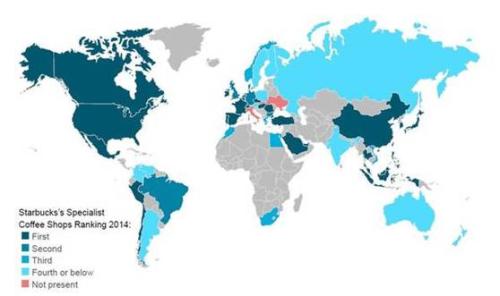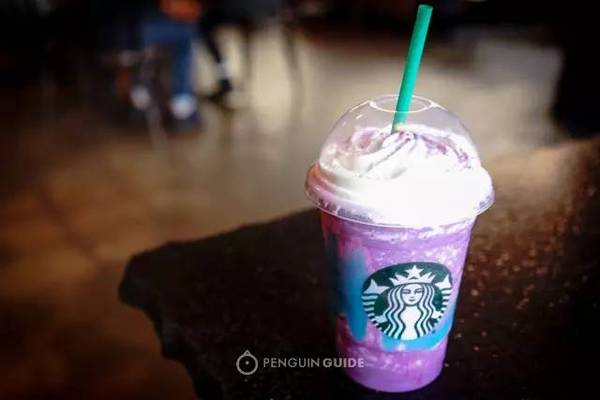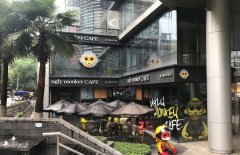The more Starbucks, the more dynamic the city! What is the logic behind this?
Professional barista communication, please pay attention to coffee workshop (Weixin Official Accounts cafe_style )
Ten o'clock in the morning is the time when many office workers arrive at the company. The three chain coffee shops in an office building on Chaoyangmen Street have very different traffic: COSTa and Cat Shit Coffee have a small queue and can buy a cup of takeaway coffee in five minutes; Starbucks next door has a large queue and it takes at least 10 to 15 minutes to buy a cup of coffee.
Beijing now has the second-largest number of Starbucks stores in the country, with 231, far below Shanghai's 539. In China, Shanghai, Beijing, Hangzhou, Shenzhen and Guangzhou rank among the top five Starbucks stores.
A recent article in the 21st Century Economic Report found that the number of Starbucks stores, disposable income of residents, per capita consumption of tourists, regional GDP, etc. became important indicators to measure the activity of business and consumption in a region.
At the beginning of the year, Wang Yongkang, secretary of Xi'an Municipal Party Committee, lamented that the current situation of 40 Starbucks in Xi'an was far from enough. Behind the disparity in the number of Starbucks stores between Xi'an and Shanghai was the gap in economic strength between the two cities.
The number of Starbucks coffee stores measures the commercial competitiveness and consumption vitality of a region, which is called the Starbucks algorithm.
So many competing brands, why Starbucks?
This kind of consumption logic is not difficult to understand, but why is Starbucks the first among many chain coffee brands?
Even coffee lovers can hardly tell the difference between Starbucks and other coffees without prompting. Starbucks 'taste and craftsmanship are not outstanding compared with some handmade coffee shops.
Starbucks takeaway coffee basically does not pull flowers this thing, you know beautiful fancy shape is the reason why many people choose to drink coffee ah!
However, whether it is Korean brand coffee, or Chinese cat feces coffee, even Costa, which has long surpassed Starbucks in the UK market share, has failed to kill Starbucks in the competition of chain coffee brands in the Chinese market.
Starbucks has long set the standard for Chinese coffee chains
Business in office buildings is not unnoticed by other brands, but it seems that Starbucks is not as eye-catching.
Starbucks was the first of the above-mentioned chain coffee brands to enter the Chinese market. Compared with Costa, which entered China in 2006, and Man Coffee, which entered China in early 2011, Starbucks, which entered the Chinese market in 1999, set the standard for the Chinese chain coffee market early.
Starbucks standardized coffee making, which made the coffee you drank in any store in China taste the same, which provided the basis for Starbucks 'rapid chain expansion.
At the same time, the streamlined operation greatly shortens the coffee making time. In Starbucks, 5 minutes from ordering to making is enough for a cup of coffee to reach the customer.
This greatly reduces the cost of customer waiting time and improves efficiency per unit time.
Starbucks has become a dominant player in the Chinese market while other chain brands are still exploring the market, setting the standard for the industry.
Maximizing efficiency is at the heart of the business model
Efficiency here mainly refers to efficiency per unit time and plateau efficiency.
The more coffee sold in a certain period of time, the more efficient the store is, and the stronger the natural profitability. The smaller the size of the store, the more coffee sales, the better the effect.
Starbucks 'takeout far exceeds in-store consumption, and the takeout coffee business adds efficiency to Starbucks, which is at the heart of Starbucks'"money printing machine" philosophy.
In addition, the high frequency of customer consumption, the unit price of high customers, and the smoothing of consumption time period have brought amazing sales volume to Starbucks, which is also an important reason why Starbucks can maintain rapid growth.
Starbucks Global Distribution Map
Starbucks has expanded globally. As of 2017, Starbucks had more than 26000 stores in 75 countries worldwide.
Among them, the Americas accounted for 61.4%; Europe, Middle East and Africa accounted for 10.6%; China and Asia-Pacific had more than 7000 stores, accounting for 26.5%, of which Starbucks had opened more than 2600 stores in more than 120 cities in China.

Starbucks first arrived in China in 1999, when many people were not optimistic about the development of this imported beverage brand. Indeed, Starbucks had a tough time in China before it became the second-largest consumer after the United States.
Starbucks will continue to expand at a rate of 500 new stores a year over the next five years, according to the 21st Century Business Report. That means Starbucks will open nearly as many stores in the mainland of China in the next five years as it has in the past 18 years combined.
The total number of Starbucks stores in the top 12 cities is 1608. Except Suzhou, these cities are municipalities directly under the central government, provincial capitals or sub-provincial cities. The GDP of these 12 cities was 17.63 trillion yuan in 2016, accounting for 26% of the national GDP.
The economic industries, employment opportunities and educational resources of these cities are far superior to those of other regions, and from a direct perception, these cities basically include China's fastest-growing regions.
What is the logic of Starbucks algorithm?
What is the logic behind Starbucks? Who buys the coffee Starbucks sells every day? What does this purchase say?
Starbucks in office buildings: indirectly reflecting the vitality of urban capital
In many Grade A office buildings in Beijing and Shanghai, Starbucks stores can be seen everywhere, even if it is two or three hundred meters. Whether it is Shanghai's Lujiazui (23.26 -1.86%, diagnostic stock) financial center or Beijing's Guomao Zhongguancun (8.17 +0.49%, diagnostic stock), the restaurant stores in the office buildings are always frequently replaced, but Starbucks hidden in them will never lack customers.
Office workers with fast pace of work are the target users favored by Starbucks. Being able to take out, fast and close to the company are the main consumption demands of this group of people. Therefore, it is undoubtedly the best choice to open coffee shops into office buildings.
The number of Starbucks stores indirectly reflects the number of commercial centers and office buildings, while the size of commercial centers and Grade A office buildings can reflect the capital vitality of a city.
Consumption capacity upgrade: when Starbucks becomes daily from light luxury
Once upon a time, ordering a cup of coffee in Starbucks for an afternoon, or going to Starbucks for various photos, or a light luxury lifestyle ridiculed by people, such phenomenon corresponds to a certain social reality.
Starbucks is not cheap. Take the most common latte, for example, priced between 29 and 35. For many people, Starbucks as a daily drink is still a very burdensome thing.
Therefore, maximizing the use of Starbucks as a "third space" attribute, taking photos or killing time can improve the cost performance of this consumer behavior.
When the queue in the store is endless, more consumers choose to take out rather than eat in, which shows that Starbucks '"third space" attribute is being diluted, and it also shows that Starbucks consumption is becoming routine.
Behind this change in consumer behavior is an increase in the number of middle-class people in a city.
Although it cannot be strictly defined, generally speaking, the middle class has a higher consumption ability, pays more attention to the brand's favorable degree when consuming, and they are more willing to pay for the emotional premium of the brand.
This may explain why starbucks wins over competing brands.
The larger the number of middle-class people in a city, the stronger its competitiveness and activity in economy, education, culture, etc. Similarly, the more urgent the city's demand for high-quality consumption behavior, which has won Starbucks a considerable market.
In fact, if the Starbucks algorithm is established and the number of Starbucks stores becomes one of the indicators of regional economic vitality, it is no longer important whether Starbucks coffee tastes pure or not.
Starbucks 'concept of "third space" has been gradually diluted, and the transformation trend of "de-coffeification" has begun to emerge. Starbucks is no longer satisfied with being a coffee roasting enterprise.
In the 18 years since entering the Chinese market, Starbucks has witnessed the transformation and upgrading of Chinese consumption and is trying to adapt to and cater to this change.
It's not just making coffee. This is the secret of Starbucks 'ability to firmly grasp China's middle class.
Important Notice :
前街咖啡 FrontStreet Coffee has moved to new addredd:
FrontStreet Coffee Address: 315,Donghua East Road,GuangZhou
Tel:020 38364473
- Prev

Starbucks is in Seattle, its birthplace. What's different from what you drink?
Professional baristas Please follow the Coffee Workshop (Wechat official account cafe_style) recently, Starbucks launched a limited drink Unicorn Frappuccino (Unicorn Star Frappuccino), which is sold for only five days. As it happens, Mr. Penguin was playing chu (chai) in Seattle at that time, and naturally he could not avoid vulgarity to have a drink. It did look like the girl's heart burst, but it was a pity that it was too sweet.
- Next

Chongqing beautiful signboard | this coffee shop is actually called "strange ugly monkey"?
Professional barista communication Please pay attention to the coffee workshop (Wechat official account cafe_style) generally mention small animals, everyone's inherent impression is cute, soft, cute, if someone uses the word ugly to describe animals, everyone will think it is a bit inappropriate! But today, this beautiful sign in Chongqing is different. It not only uses animals as signs, but also says that this animal is ugly.
Related
- What documents do you need to go through to open a coffee shop? coffee shop coffee shop certificate processing process
- How to purchase Coffee beans in small Cafe how to choose a suitable supplier for domestic Coffee supply Company
- How to drink Starbucks Fragrance White Coffee? how to make Australian White Coffee? what Italian coffee beans are recommended?
- The Story of Flora Coffee: the name of Flora Coffee Bean and the implication of the Flowers on Florna Coffee
- How much does a cup of coffee cost? How much is the profit of a cup of coffee? What is the profit of the coffee shop in a year?
- Yunnan small Coffee, known as "fragrant Coffee", introduces the characteristics of Alpine Arabica Coffee producing areas in Yunnan, China
- 2023 latest Starbucks full menu price list how much is a cup of Starbucks coffee what is better to drink the most popular hot and cold drinks recommended
- Starbucks different kinds of Coffee Price list Starbucks menu 2023 Top Ten Best drinks in Starbucks
- Starbucks Spring praise Comprehensive matching Coffee Bean theme Story Packaging implication and taste description
- The cost of a cup of coffee latte American coffee cost price and selling price

